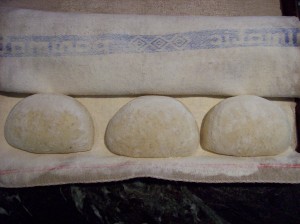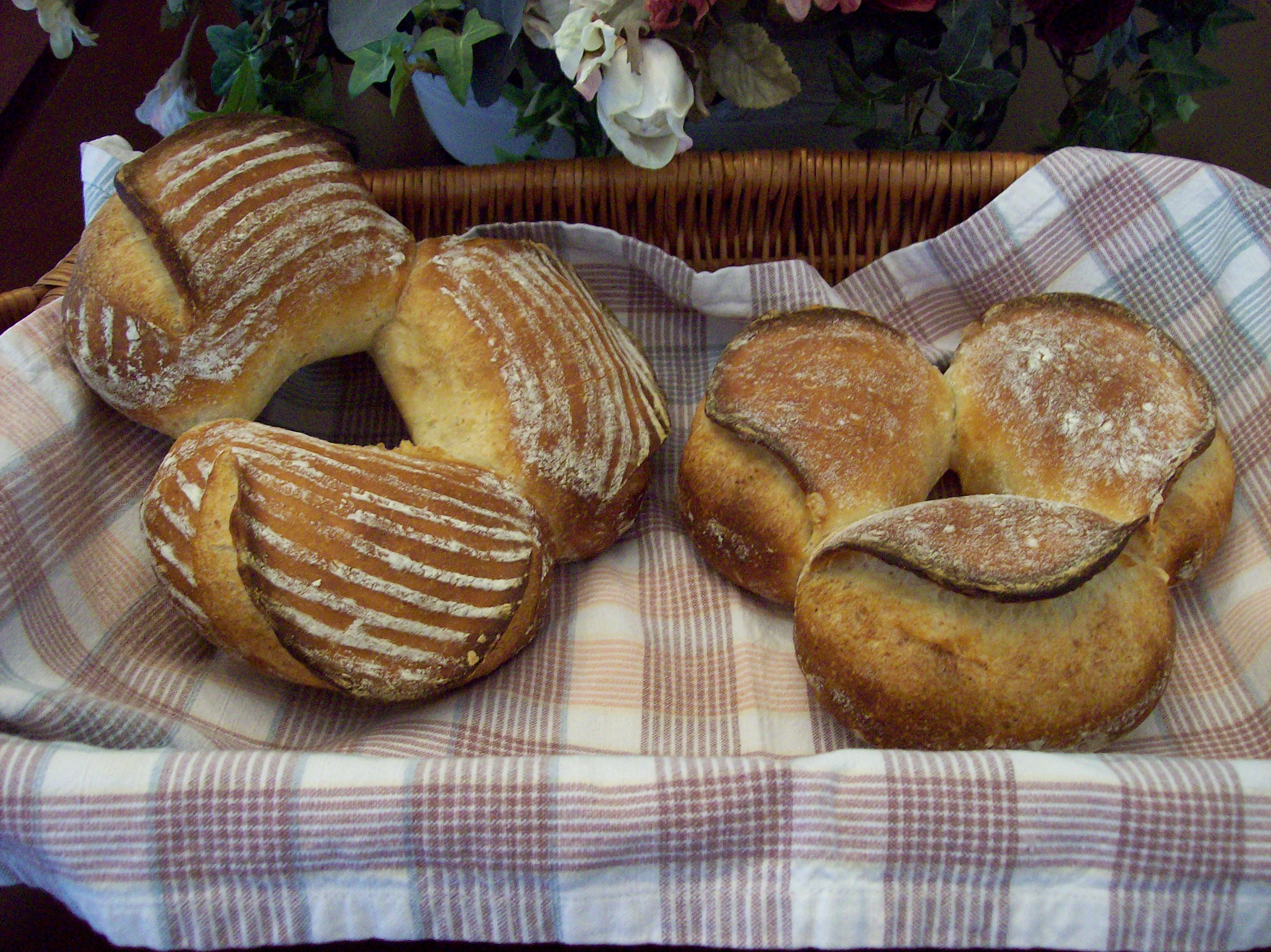Pain de Campagne Redux – Diad┴¿me
Sep 13th, 2008 by SteveB
Learning or creating new bread shapes has always been great fun for me. Yes, my goal is to always bake bread with a seductive aroma, flavor and texture, but as someone obsessed with trying to bake the best possible bread that I can at home, visual appeal is also a big part of the story.
I’ve always been intrigued by the shape known as a couronne, or crown.á To produce this shape classically requires a specialized proofing basket , which can be fairly expensive to acquire.ááI decided to see if I could come up with a way of producingásomething similar to a couronne without the expensive hardware.ááWhat evolvedáwere twoámethods of producing a smaller version of the couronne.á But what to name this new shape?ááAfter a briefáconsultation with Janedo, our resident French bread connoisseur over at …Au Levain!, we came up withádiad┴¿me, or tiara.á Yes, a modern-day tiara is typically semi-circularábutáthe early tiaras coming out ofáancientáMesopotamia and Persiaáwere full circle (how’s that for a stretch?).áá
When looking at a couronne, I was always struck by the fact that it looks a bit like six tabati┴¿re (tobacco pouch)áshapes linked together in a circle.á Why not, then,álink three individual tabati┴¿re shapes in a circle?á This can be done in one of two ways,áeither by : 1)áplacingáthree tabati┴¿re shapes, inverted,áinto a floured brotform or banneton, with an inverted drinking glass (its outside lightly oiled) atáthe center to maintain the void space and thenáproofing orá2) proofing three individual tabati┴¿res on a couche and, immediately prior to oven loading, placingáthe three tabati┴¿res on the peel together in a circle and allowng the oven spring to conjoin the individual segments in the oven.
ááá

For both methods, I’ve used pain de campagne dough, the formula foráwhich is described here, although there is no reason other doughs could not be used.á The shapingáof theádiad┴¿me using aábrotformácan be seen below (notice a small bit of oil is used to enhance definition):
[qt:http://www.breadcetera.com/wp-content/uploads/2008/09/PetitDiademe002.MOV 500 375]
Inverting the brotformáonto a peel and loading the oven is seen here:
[qt:http://www.breadcetera.com/wp-content/uploads/2008/09/Diademe003.MOV 500 375]
I wonder if this shaping technique will make its way onto YeastSpottingáoráCLICK: Crusts?ááááá

I love it! Using the tabatiere shapes is brilliant and I quite like the 3-cornered shape.
Very creative Steve! It seems to work well and the results are very classical looking,
Eric
Truly inspiring, your mini-couronnes, diad┴¿mes, petits joyaux tr┴¿s mignons. So glad they worked out. I love the tabati┴¿re shaping.
Jane
Hmmmm….this shape is not really new. It has been used by team Japan in the 2002 Coupe du Monde.
Susan, Eric and Jane, thank you all for your gracious comments.
Jim, thanks for bringing the work of 2002 team Japan to our attention. I should’ve realized that just because I’ve never seen it before doesn’t mean that it’s never been done before.
I have so much to say I don’t know where to begin!
– First off, I love your technique. I was just reading this folding style the other day but wasn’t quite confident on the actual action. Thanks to you that’s all clear now!
– What was that you used to inject steam into the pan?
– Do you not experience some major heat loss issues with leaving your oven door open that long?
– Finally, I WANT YOUR OVEN! ƒÿë
~Tablebread
Tablebread, I’m glad you found the post of some value.
The device I use to inject steam is a simple, hand-held clothes steamer. The details of the steaming technique can be found here.
To minimize temperature recovery time when the oven door is opened and closed, I’ve attempted to increase the oven’s thermal mass by placing a roasting pan filled with clean landscaping stones on the floor of my oven. It seems to do the trick.
You can have the stones, but you can’t have my oven! ƒÖé
First, sorry for my english ; I’m not yet at this step of shapping, although, I’m watching your video all day long…it’s impressive how it seems so natural and simple for you, but in the reality of my kitchen it never looks so good, but I’m an obstinate person.
C┴®cile, your English is much better than my French!
It took me a while to learn proper shaping technique… and I’m still learning! Keep practicing. Soon it will become much easier.
I enjoyed the pain au levain post on your blog. I thought your comments about Los Angeles were “tr┴¿s dr┴┤le”. ƒÖé
Hello! I’m from Spain, I’ve seen your blog for the first time and I think it is one of the most espectacular and interesting. I’m so “novice” in bread’s world and I was scared about writing to you but finally I do it.
I’ve known you from Ye Olde Bread Blogge (for me, one of the best blogs too). Like it I’m going to link you in my blog. I hope you like it.
Thanks so much!
M┴▓nica
Hola M┴▓nica! I am very glad you decided to write. There is no reason to feel scared about writing. We are all here because we share a love of baking. I would love to see more people from other parts of the world write, as you did.
Thank you for the kind words and for the link on your blog. You have some wonderful breads on your blog. The panecillos de chocolate look particularly inviting.
Wow, Steve, those tiaras are so lovely!If only they could be on my breakfast table tomorrow morning… ƒÿë
And thank you so much for inserting makanai in your links, I’m extremely honored! Sorry I don’t have -yet- an english version…
Hi Flo. Thanks for the compliments. I love your blog because you not only have some very nice breads (and other wonderful food as well), but it also gives me a chance to practice my French!
[…] Pain de Campagne Redux – Diad┴¿me ~ Bread cetera […]
Looks great. They’re just barely attached to each other. The crust on top must be delicious.
beautiful bread. can’t a bundt pan be used for couronne?
bee, it might be problematic using a bundt pan because, if I remember correctly, the inner cylinder of a bundt pan goes almost all the way up to the pan’s rim. This might result in an overly large flap of dough to fold over each dough ball. If you decide to try it, please let us know your results.
[…] Focaccia @ Health Nut Rye bread with chevron cuts @ Wild Yeast Pain de Campagne Redux – Diademe @ Bread cetera Click crust for Jugalbandi @ Sindhirasoi Chocolate Custard Muffins @ Cherrapeno Tartelettes au […]
Beautiful diadems!
I must say that I really like this tabati┴¿re shape – many thanks for the video showing how to achieve it. And you used just regular vegetable oil on the lip of each tabati┴¿re?
I’m also really intrigued by the way you pushed the bread onto the stone. It seems to be much less stressful for the bread than my method of wrist jerking it off of our peel. Very cool.
Elizabeth, thanks for the compliments. I use just regular vegetable oil when shaping the tabati┴¿res. The peel I use to load my bread into the oven is a custom-made Super Peel(TM). They can be found here.
I’m really intrigued by this peel. I already have a pretty good wooden peel that is just the right size for me. (Your superpeel looks huge!) Do you think it might be possible to buy just the cloth part and dowel and attach it to an existing peel, or is there something special on the superpeel itself? (I saw on the superpeel website that the cloth does come off for washing)
Elizabeth, my Super Peel was custom made for me a number of years ago. I worked with Gary over at Exo Products to have it sized specifically for my wider-than-conventional oven. The Super Peel is not just a regular peel with a cloth fitted to it; it requires a bit of woodworking to produce.
Love the shape! Tempted to put a floured sock over the glass to prevent sticking. Lovely!
Thanks, Sarah. I coated the outside of the glass with some vegetable oil to prevent sticking but probably could have used a bit more.
[…] I didn’t know what those were either before reading Steve’s (Bread cetera) post about making diad┴¿mes (tiaras) by pushing tabati┴¿res (tobacco pouches) into a circular shape. Steve made videos, one of […]
COULD YOU PLEASE GIVE AN APPROXIMATE WEIGHT OF ONE OF THE THREE SECTIONS OF THIS LOAF — I WOULD GUESS IF I MAD THE DOUGH AS LISTED IN THE PAIN DE CAMPANGE RECIPE THERE WOULD BE QUITE A BIT LEFT OVER — THE LOAF IS BEAUTIFUL —
TONY
TonyK, why not just divide the dough obtained from the pain de campagne recipe into six equal-sized pieces to prepare two loaves? The exact size of the final loaves is just a matter of personal preference. You can make the loaves as small or as large as you wish.